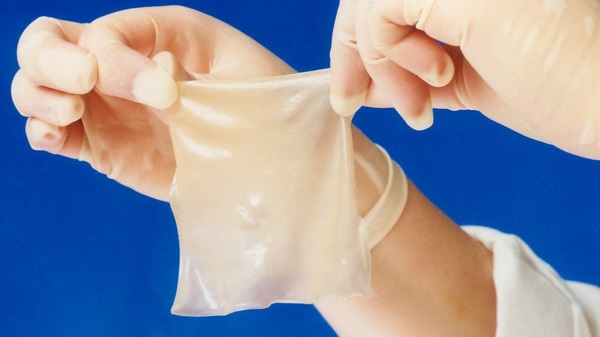The human skin replacement that got experts buzzing
An enormously elastic protein that has numerous useful medical applications – from treating acne scars, stretch marks and burns to healing surgical wounds, fixing broken arteries and coating prosthetic implants – will soon be available to patients in numerous countries.
Elastagen, a spin-off company created by University of Sydney scientists who perfected the technique for industrially producing the protein, was sold to major global biopharmaceutical firm Allergan for $360 million last year.
It is one of the biggest success stories so far of the NSW government’s Medical Devices Fund (MDF), which has provided $6 million of support to develop and commercialise this technology since 2013.

A protein like an elastic band
The technologies developed by Elastagen are based around a molecule called elastin, which accounts for the elastic properties of many of the body’s tissues, such as the intestines, heart and bladder.
It can stretch to eight times its length, making it the perfect material to support the needs of organs such as the lungs and circulatory system. The elastin in a blood vessel, for example, may last a lifetime, stretching and relaxing through two billion pulsations of the heart.
“Anywhere in the body you need to stretch and recoil, you have elastin,” says Elastagen CEO Robert Daniels. “It’s quite a remarkable protein because it’s rather like nature has produced an elastic band.”
While elastin is produced in greatest quantities during foetal development, it may also play a role in repairing adult tissues, “so if you use elastin materials in the right way, then you can repair or regenerate tissues such as skin, or blood vessels,” he adds.
It was long ago realised that elastin might have useful medical applications, but extracting it from animal tissues was problematic. Instead, during the 1990s, a team led by Professor Anthony Weiss, University of Sydney McCaughey Chair in Biochemistry, developed a technique to use microbial cells to produce large quantities of a precursor of elastin called tropoelastin.
They put the genetic instructions for human tropoelastin into a bacterium, in a so-called recombinant DNA technique that was similar to how cells are used to manufacture insulin for diabetics.
Injectable gels to prevent scarring
The technology was patented, resulting in 2005 in the spin-off company Elastagen, which was supported by MDF grants in 2013 and 2017.
The initial focus of the company was on the development of injectable gels of recombinant tropoelastin to repair skin structures such as acne scars, stretch marks and to treat wounds, as well as applications in cosmetic surgery. The tropoelastin, which is identical to the protein found in our own bodies, creates a natural environment within which cells are enticed to grow.
It is now also in development to help repair skin following excisions, such as when a carcinoma is removed.
“Tropoelastin supports a natural wound-healing process that enables the skin to repair and reduces the appearance or development of the scarring,” Daniels says. “You’re injecting a material that creates the perfect environment to support cell growth in a way that is natural.”
Another product in early development is a surgical glue, which is highly elastic and adhesive, and can seal a wound in 60 seconds. ‘MeTro’ shows particular promise in closing wounds in tissues that expand and contract, such as those of the heart and lungs. The product, shown to be effective in animal trials in a 2017 study in the journal Science Translational Medicine, may one day replace stitches, potentially revolutionising surgery.
Far future applications
No other protein is anything like recombinant tropoelastin in having this huge range of applications, Daniels says. “It’s completely unique.”
Looking much further into the future, tropoelastin could one day have potential in the stem cell and regenerative medicine space, he adds. “There are opportunities to combine the material with stem cells to regenerate functional tissue such as blood vessels, which in the future will clearly be a huge opportunity.”
As more progress is made around robotics and mechanical implants, tropoelastin might have uses in making these devices more biocompatible with the human body too, by forming a coating that prevents them being recognised as foreign objects. “You can get responses to those types of implants that you don’t want – fibrotic responses and immunological responses at the site of the implant that you can control with a protein such as tropoelastin.”
Giving back to the Medical Devices Fund
These are applications that are still in conceptual stages, however. The tropoelastin treatments for repairing acne scarring and other skin damage have clinical data to show they work. Now with global firm Allergan behind them, they are going through regulatory approval and moving towards product launch, Daniels says. Allergan’s international reach will also mean these products will likely become widely available in many parts of the world, rather than just Australia.
The successful sale of Elastagen to Allergan also means they can repay the $6 million to the MDF, which can be used to support other bright ideas for life-improving technologies. “As one of the first recipients of the Medical Devices Fund, we’ve also been the first to repay the grant funding we received,” Daniels says.
“Our technology has come a long way from the lab bench at the University of Sydney,” said Professor Weiss last year, who was in 2018 awarded the Order of Australia for his efforts.
By John Pickrell
Updated 4 years ago
